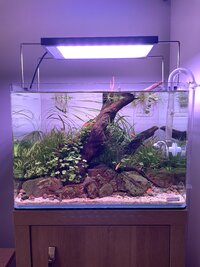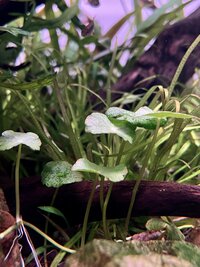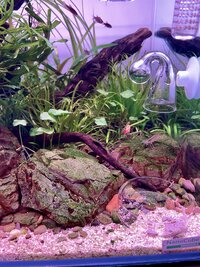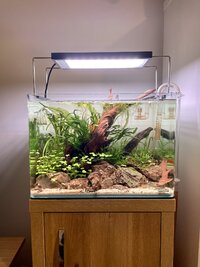Hello!
I have a Dennerle 35 Scapers tank that has been running since September 2021 and it’s my first high tech setup with a Chihiros WRGB2 and pressurised Co2 system. I previously had the light set up at 50-60% intensity for 6 hours a day, but a couple of months ago I increased this to 8 hours as the tank was more established and the plants were doing well, so I thought this would improve their growth even more. This caused GSA to start appearing on the rocks at quite a fast rate and so I recently reduced the lighting intensity down to 40-50%, still for 8 hours a day.
Before this change the plants were doing great and growing really well, but in the last couple of weeks I’ve noticed a big slow down in their growth rate. On top of this the GSA is still there and I’m now also starting to get staghorn algae on the plants!
Today I calculated my Co2 levels using PH and KH and I discovered that my Co2 level is actually higher than it should be. I’ve always had a drop checker in the tank which reads as light green and so I assumed this was good, but when I did the KH and PH tests, my KH read as 4.5-5 and my PH was 6.6, resulting in a Co2 level of around 30-37ppm.
Almost all of my plants are classed as “Medium” by the Tropica website and so I was wondering if I should either:
1. Reduce the Co2 amount first as they naturally require less and this could also match my newer lower lighting intensity?
And/Or
2: Just go back to 50-60% lighting intensity for 6 hours a day as from what I remember this seemed to have the best plant growth.
Then again, I’m not sure if the initial fast plant growth was because the setup was newer and so there were maybe more ferts available for the plants in the soil, as it is the ADA Amazonia soil. The only other ferts I’ve been adding to the tank is a daily dose of 2hr aquarist apt zero.
Either way, with all of the variables between lighting, Co2 and ferts I’m a bit overwhelmed on how best to solve this or where even to start 😅
Any help or advice would be very much appreciated, thank you!
I have a Dennerle 35 Scapers tank that has been running since September 2021 and it’s my first high tech setup with a Chihiros WRGB2 and pressurised Co2 system. I previously had the light set up at 50-60% intensity for 6 hours a day, but a couple of months ago I increased this to 8 hours as the tank was more established and the plants were doing well, so I thought this would improve their growth even more. This caused GSA to start appearing on the rocks at quite a fast rate and so I recently reduced the lighting intensity down to 40-50%, still for 8 hours a day.
Before this change the plants were doing great and growing really well, but in the last couple of weeks I’ve noticed a big slow down in their growth rate. On top of this the GSA is still there and I’m now also starting to get staghorn algae on the plants!
Today I calculated my Co2 levels using PH and KH and I discovered that my Co2 level is actually higher than it should be. I’ve always had a drop checker in the tank which reads as light green and so I assumed this was good, but when I did the KH and PH tests, my KH read as 4.5-5 and my PH was 6.6, resulting in a Co2 level of around 30-37ppm.
Almost all of my plants are classed as “Medium” by the Tropica website and so I was wondering if I should either:
1. Reduce the Co2 amount first as they naturally require less and this could also match my newer lower lighting intensity?
And/Or
2: Just go back to 50-60% lighting intensity for 6 hours a day as from what I remember this seemed to have the best plant growth.
Then again, I’m not sure if the initial fast plant growth was because the setup was newer and so there were maybe more ferts available for the plants in the soil, as it is the ADA Amazonia soil. The only other ferts I’ve been adding to the tank is a daily dose of 2hr aquarist apt zero.
Either way, with all of the variables between lighting, Co2 and ferts I’m a bit overwhelmed on how best to solve this or where even to start 😅
Any help or advice would be very much appreciated, thank you!






